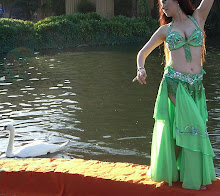Over my years of performing belly dance – whether at Middle Eastern restaurants, private events, or teaching workshops – the two questions that I have been asked most have been:
-- What nationality am I?
-- How did I get into this dance form?
The music, movements, costumes, and props associated with belly dance are foreign enough for most Americans, let alone seeing me, an Asian person, sporting waist length wavy hair, a bust line enhanced by a jeweled bra, and apparently almond-shaped eyes. It must be difficult for a lot of people to connect the dots! They don’t know whether to place me in the Far East, Middle East, Near East … East Asia, Central Asia, South Asia, or Asia Minor.
My quick answer to the second question is always that I have been dancing, or rather learning one dance form or another, for as long as I can remember. As a little girl, I wanted to dance like one of the swans in “Swan Lake.” As a penniless grad student, my scholarship paid not only for classes in my chosen field but also dance classes. As an adult, dancing keeps me in shape mentally and physically.
I was born in Shanghai – nowadays famous as the city with the most construction cranes outside of Dubai. Believe it or not, it is thanks to this Far Eastern origin that I had my first exposure to “Oriental” or Middle Eastern dance at a very early age. Growing up, we were taught that the Uyghur minority of Western China, a Turkic people, were true comrades and that we should be proud of their culture as part of our own. This included learning some Uyghur dancing in elementary school. I really became absorbed by their dance styles, however, when I was thirteen years old. My mother was in the hospital for a hip injury and, entirely by chance, her roommate there was one of the greatest Uyghur dance artists (and one of my idols), Mai Li (I wish I had known her Uyghur name). Mai Li entranced me with her poise and beauty. Nowadays, when people occasionally think I’m Kazakh or Uzbek (Turkic ethnicities similar to the Uyghurs), I like to think that I come across like Mai Li!
Mai Li is one of the most beautiful women I’ve ever seen. Her features are the perfect mix of East and West, her waist-length hair flows into 8 braids, and she speaks Mandarin with the cutest accent! To me, she seemed like a goddess. I still remember the day she taught me how to perform a head slide. Like many children, I was not well coordinated and couldn’t isolate one part of my body from another. She asked me to stand under the door frame, gently closed the door with my shoulders jammed within, and then asked me to slide my head from one shoulder to another. Bam! I had it. That was my very first Oriental dance lesson and this is still how I teach my students to execute a head slide to this day.
In case you’re wondering, Uyghurs are the largest minority group of Turkic origin in China. They live primarily in the Xinjiang Uyghur Autonomous Region (新疆维吾尔自治区) and are predominantly Muslims. Uyghurs have their own language, dress, food, music, and dance, all shaped by Turkish, Central and South Asian, and Middle Eastern influences. Their dance movements include head slides, back bends, snake arms, and flower hands, with dance props such as tambourines. By the way, the award-winning film “The Kite Runner” – set in Afghanistan – was actually filmed in Xinjiang, not in Afghanistan. Apparently, Kashgar (the city it was filmed in) looks a lot like Kabul – but was not a war zone.
I say “was not” because, since the filming of the movie, unrest has spread throughout Xinjiang. Due to restricted press access there, it is not really clear what kind of situation prevails.
It is my belief that peace can be achieved through communication and dialog. Music, dance, and the arts are the perfect media for this. For example, in the opening ceremonies of the 2008 Beijing Olympics, it was wonderful to hear a song by the best-known Uyghur singer, Abdullah Abdurehim. I was also relieved when President Barack Obama, shortly after taking office, ordered the release of four Uyghurs from Guantanamo Bay – after 7 years of confinement by the Bush Administration. These two events made me feel very hopeful for peace for the Uyghur people.
The dictionary says that “world peace” is an ideal of freedom, peace, and happiness among and within all nations and/or peoples. The world is getting smaller every day and we are all citizens of the world. Let’s all make our contributions towards the world peace by acknowledging the differences and similarities of people of all faiths, backgrounds, and cultures. I do this via my art form and you should do so via your own path.
Please enjoy some beautiful Uyghur song and dance!
Sunday, November 29, 2009
Subscribe to:
Post Comments (Atom)

No comments:
Post a Comment